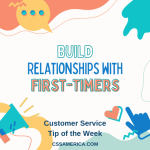Unfortunate but true story…
The manager basically lost his mind. He terminated his employee on the spot. She had told the customer that there was going to be a delay in the shipment. The employee called up the customer ahead of time to let the customer know what was about to (or not about to happen), and to see what the customer wanted to do. The only options were to wait for the late shipment or to cancel the order.
The manager was livid. His employee had put the sale at risk by telling the customer about the impending delay and letting the customer know they could cancel.
The next day, the manager called the employee, was contrite, apologized profusely, and asked the employee to come back to work.
This employee was one of the best in the office. She was being proactive with the customer. She had the customer’s best interests at heart, and she was trying to provide good customer service.
The manager was so focused on the potential lost transaction that he didn’t recognize everything that his team member was doing, and why she was doing it. He was so focused on that potential lost transaction, that he didn’t consider the magnitude of the loss of one of his best employees, the potential loss of her clients, the loss of trust and credibility with those employees who remained.
Fortunately for the manager, the apology worked. It was basically a miracle that he could be so knee-jerk in the reaction one day, and the next day have the employee accept the apology and say she would return to work.
There are mistakes, and then there are MISTAKES. And many of these mistakes are with our team members, our co-workers – not just with our clients. Often, the best way to address the mistakes is to quickly and sincerely apologize.
To apologize is to humble one’s self. The humility of an apology can sometimes work miracles.
Signup for FREE Tips! Contact Us More Resources for You Visit Our Home Page
























